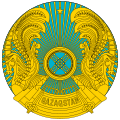Kangar union
This articleneeds additional citations forverification.(August 2011) |
Kangar Odagy | |||||||||||||||
|---|---|---|---|---|---|---|---|---|---|---|---|---|---|---|---|
| 659–750 | |||||||||||||||
 The Kangar Union after the fall of the Western Turkic Khaganate, 659-750 | |||||||||||||||
| Capital | located in Ulutau mountains | ||||||||||||||
| Common languages | Old Turkic | ||||||||||||||
| Religion | Tengriism | ||||||||||||||
| Khan (title) | |||||||||||||||
| Legislature | Kurultai(Qurultay) | ||||||||||||||
| History | |||||||||||||||
• Established | 659 | ||||||||||||||
• Disestablished | 750 | ||||||||||||||
| |||||||||||||||
| History of the Turkic peoplespre–14th century |
|---|
 |
| History ofKazakhstan |
|---|
 |
Kangar unionwas aTurkicstate in the territory of the entire modernKazakhstanwithoutZhetysu.The ethnic name Kangar is anearly medievalname for theKanglypeople, who are now part of theKazakh,Uzbek,[1]andKarakalpaknations. The capital of the Kangar union was located in the Ulytau mountains. The Pechenegs, three of whose tribes were known asKangar(Greek:Καγγαρ), after being defeated by theOghuzes,Karluks,andKimek-Kypchaks,attacked theBulgarsand established the Pecheneg state in Eastern Europe (890–990 CE).
Etymology
[edit]TheKengeres,mentioned in theOrkhon inscriptions,were possibly known in the Islamic world and in the west asKangar,a collective name for threePechenegtribes (of eight).[2]ByzantineemperorConstantine Porphyrogenitusstated thatKangarsignified nobleness and bravery.[3]Ukrainian historianOmeljan Pritsaksuggested thatKangaroriginated fromTocharian A*kânk"stone" andKengerescombinedKengerwith the Iranian ethnonymAs,supposedly from *ârs< *âvrs< *Aoruša(Greek:Αορσοι). However, Golden objected that *Aorušawould have yieldedOrs/Ursand Pritsak's opinion on the Kengeres-Kangars' ethnonym and mixed Tocharian-Iranian origin remained "highly hypothetical".[4]Other Orientalists,Marquart,Toltsov,Klyashtorny,attempted to connect theKangarandKengeresto theQanglı,the eastern grouping of theCuman-Kipchak confederationas well as the Indo-EuropeanKangjuin Chinese sources. Akhinžanov proposed that theKipchakssimply assumed the nameQanglı(literally "wagon" ) after taking over theKang region.[5]András Róna-Tas(1996, 1999) proposes that the Pechenegs associated with their wordkongormeaning "brown" (referring to their horses'coat color) with the ethnic name Kangar, which had been in existence in the Caucasus region as early as the 6th century CE before the Turkic peoples emerged; though he considers it a "case of an ethnic name established by means of apopular etymology".[6][7]Nevertheless, all of these connections, if any, remain unclear.
Independence
[edit]After the capture ofZhetysuby theChinese,Kangars become independent from theTurkic Kaganate.The Syr Darya cities retained their autonomy. TheOguzesin the southernKazakhstan,Kimaksin theIrtysh Rivervalley,Cumansin Mugodjar, andKypchaksin the northern Kazakhstan became the vassals of the Kangar union.
At the end of the 7th century the Syr Darya cities rebelled and formed an alliance with theSogdiana.The revolt was successful, but theMuslimArabarmies attacked Sogdiana from the south. The revolt has waned, and Kangars consented to the continued autonomy of the Syr Darya cities.
Fall of the Union
[edit]At the beginning of the 8th century theOghuzconfederation and the city ofTashkentseceded from the Kangar union. The Arabs continued raidingSygnakh,Jend, and other rich Kangar cities. The Oguzes formed an alliance with theKimaksandKarluks,and their joint assault defeated the Kangars, whose union dissolved.[8]Three Kangar tribes and five allied Turkic tribes, under the collective namePecheneg,later carved out a realm, which bordered both the Ouzes and theKhazars,in Eastern Europe.
See also
[edit]- Pechenegs
- Kankalis(a people possibly related to the Kangars)
- Kangju
- Senior Juz
- History of the central steppe
- Turkic peoples
- Timeline of the Turkic peoples (500–1300)
Notes
[edit]- ^Tolstoi V.P.Origin of the Karakalpak People//KSIE, Moscow, 1947. p.75
- ^P.Golubovsky,Pechenegs, Torks, and Polovetses before Tatar invasion,SPb, 1884. p.55, in L.Gumilev,Ancient Türks,Ch.20(In Russian)
- ^Constantine Porphyrogenitus,De Administrando Imperio
- ^Golden, Peter B. (1992).An Introduction to the History of the Turkic People.Otto Harrassowitz, Wiesbaden. pp. 264–265.
- ^Golden 1992,p. 273.
- ^Róna-Tas, András (1996).A honfoglaló magyar nép. Bevezetés a korai magyar történelem ismeretébe,p. 325-6. Cited inGüzel, Hasan; Oğuz, Cem; Karatay, Osman (2002).The Turks: Early ages.Yeni Türkiye. p. 621.ISBN978-975-6782-56-9.
- ^Róna-Tas, András (1999).Hungarians and Europe in the early Middle Ages. An introduction to early Hungarian history.Central European University Press. p. 420
- ^Golden, Peter B. (1992).An Introduction to the History of the Turkic People.Otto Harrassowitz, Wiesbaden.
Further reading
[edit]- Gumilev L.N.,History of Hun People,Moscow, 'Science', (In Russian)Ch.11.
- Kadyrbaev A.Sh.Chinese sources of Mongolian epoch about foreign political relations of Kazakhstan Türkic nomads (Kypchaks-Kangly) with peoples of Central Asia and Far East//Society and state in China. Moscow, 1982, (In Russian)
- Zuev Yu.A.,Early Turks: Essays on history and ideology,Almaty, Daik-Press, 2002, (In Russian),ISBN9985-4-4152-9


